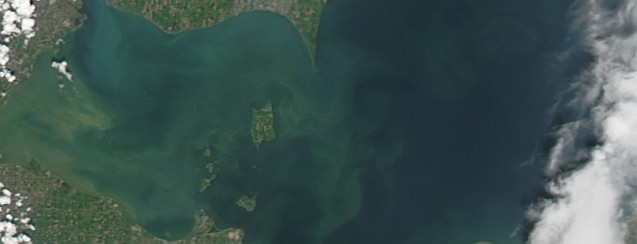
Biosensor detects toxins in water sources
UC environmental engineers’ research featured in NSF video
University of Cincinnati environmental engineers and chemists developed a biosensor to detect toxins in surface water such as streams, rivers and lakes. Funded through National Science Foundation (NSF) grants, the research was recently featured in an NSF video.
The research is led by Dionysios Dionysiou, professor of environmental engineering, and addresses the importance of detecting toxic products of cyanobacteria algal blooms, which are formed mainly by agricultural runoff. Project collaborators at UC include Vesselin Shanov, professor of chemical engineering; Ryan White, associate professor of electrical engineering and chemistry; and Bill Heineman, professor of chemistry.
The research team, including research assistant and environmental engineering Ph.D. student Vasileia Vogiazi whose work was featured in a previous article, created a sensor to identify and measure microcystins. These toxins are produced from algal blooms and can cause skin irritation, nausea or vomiting if swallowed, and liver damage if large amounts are ingested. Understanding the toxin’s impact on the water supply can aid water treatment plants to adjust the treatment strategy to keep these microcystins from contaminating drinking water.
Video courtesy of National Science Foundation.
Featured image at top: A satellite image of algal blooms on Lake Erie. Photo/Nasa.
Related Stories
New Dungeons & Dragons ethics seminar takes flight
July 7, 2025
On a blisteringly hot summer day, laughter echoed through the cool, damp basement of the Avondale branch of the Cincinnati Public Library. Young teenagers huddled around a table littered with pencils and paper, rolling dice and bonding over a game of Dungeons & Dragons. University of Cincinnati undergraduate student Charitha Anamala sat behind a trifold card with a blazing red dragon on it, serving as the group’s Dungeon Master (DM) or campaign organizer. Within the fantasy setting she described, it was hard to tell the adventure was a lesson in ethics.
UC language studies program adopts new technologies
July 7, 2025
Cultural immersion is a tried-and-true method for teaching languages. U.S. students travel abroad—to Europe, Latin America, Asia and beyond to take a deep dive into the customs, mores, daily life and conversational language that can be challenging to master from home. For those students who can't take advantage of the study-abroad experience, there's another option to gain the same learnings. At UC, the Curricular Enhancement, Development, Access and Research Language Resource Center (CEDAR) has developed a curriculum that features virtual reality (VR) technology to give students a similar opportunity right in the classroom.
Distinguished UC professor receives career achievement...
July 3, 2025
The College of Arts and Sciences Research Professor Gail Fairhurst was awarded an International Communications Association (ICA) Career Achievement Award. The Steve Chaffee Career Achievement Award goes to theoretical development or research related to communication studies. The ICA created the award in 2000 for its namesake, Steven H. Chaffee, who was a trailblazing scholar in journalism and communications academia.
